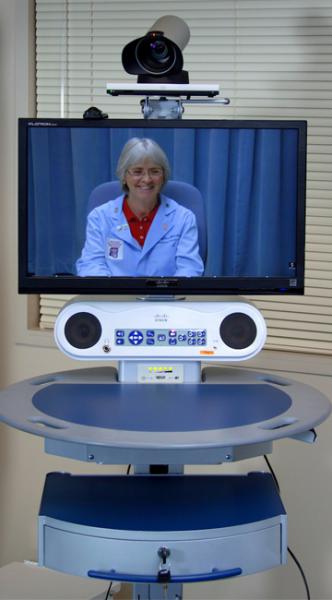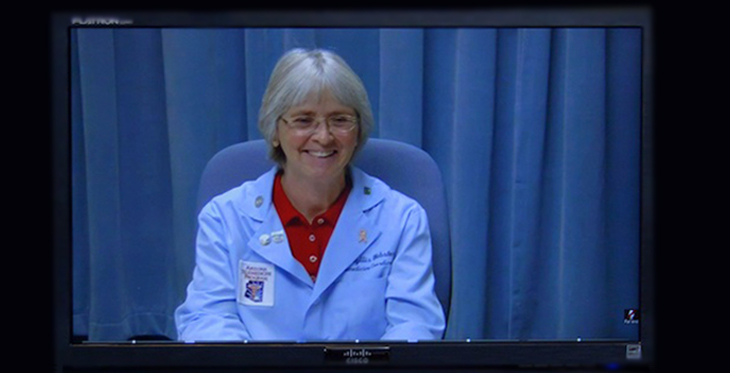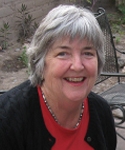Graduate school or full-time job?
That was the question Phyllis Webster was pondering after getting her bachelor’s degree in cultural and biological anthropology from the University of Arizona. In late 1996, she opted for full-time job, as a research specialist with the newly formed Arizona Telemedicine Program (ATP).
“I didn’t really know anything at all about the practice of telemedicine, and in the beginning, it was a difficult concept to visualize,” Phyllis recalls. “I had no background or interest in technology. It was the medical field environment and patient care aspects that were appealing to me.”
Six months after joining ATP, Phyllis was appointed as one of two telemedicine case coordinators, working with ATP Medical Director Ana Maria López, MD, to facilitate multispecialty teleconsultations for ATP’s eight charter sites in Arizona.
That was approximately 8,000 cases ago.
“Over the last 18 years, I have had the distinct pleasure of working with 165 consultants – most of whom were University of Arizona College of Medicine faculty – in 51 subspecialty areas,” she says.
She recalls two cases that demonstrate “how broad and richly diverse these applications can be. And that translates to an increased number of patients that can be served.”
In one case, the clinic office received an urgent request from a referring site neonatologist wanting a pediatric echocardiology evaluation on a baby that was in trouble.
 “We were able to facilitate a consultation by one of our pediatric cardiologists within a very short period of time,” she recalls. “During the real-time echocardiogram, the baby was discovered to have complex cardiac abnormalities and a recommendation was made for immediate transfer to University of Arizona Medical Center. The referring neonatologist and our pediatric cardiologists were able to view and discuss the findings as they were revealed in the study, and everyone was on the same page from the get-go. Arrangements for transfer and admission were made in advance, which further enhanced efficiency.”
“We were able to facilitate a consultation by one of our pediatric cardiologists within a very short period of time,” she recalls. “During the real-time echocardiogram, the baby was discovered to have complex cardiac abnormalities and a recommendation was made for immediate transfer to University of Arizona Medical Center. The referring neonatologist and our pediatric cardiologists were able to view and discuss the findings as they were revealed in the study, and everyone was on the same page from the get-go. Arrangements for transfer and admission were made in advance, which further enhanced efficiency.”
The second case involved a woman who lived in a rural community and suffered from a severe and chronic skin condition. The patient was so self-conscious about her appearance that she rarely went out in public.
The woman agreed to a teledermatology consult via store-and-forward, high-resolution digital imaging, and follow-up visits via real-time, interactive videoconferencing. Following the consulting dermatologist’s treatment recommendations, the patient’s condition improved steadily and markedly over the course of a few months, Phyllis says.
“She was no longer embarrassed to go out in public, began to engage in social activities and was extremely grateful for the help she received, which she experienced as life-changing.”
Ask Phyllis what interests her most about telemedicine, and she will invariably say it’s the patients – not the technology. “It can be easy to get caught up in the technology,” she says, “but it is simply a wonderful tool that enables us to communicate with, and provide care to, patients.”
Looking back on those 8,000 cases, she says, “It has truly been a unique and satisfying experience. I consider myself extremely fortunate.”
“A wide range of telemedicine and telehealth practices – from telestroke and remote ICU patient monitoring to home health care – have now been integrated into the mainstream,” she says.
“In 1996, when I would approach one of our consultants here about staffing a telemedicine referral, I was almost always met with a puzzled expression, requiring me to describe the entire process in detail. For the most part, that is no longer the case. Everyone knows what videoconferencing is now.”
As for that graduate degree, Phyllis says she is currently “chipping away at a master’s in biology.”

